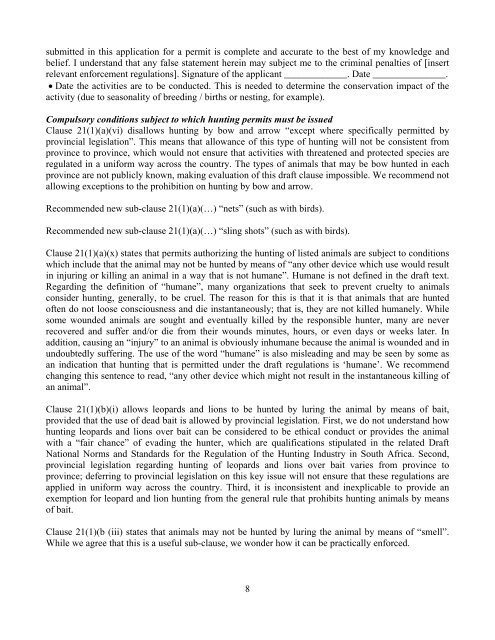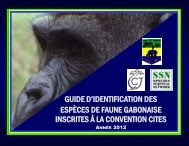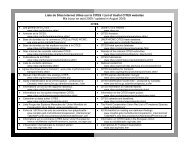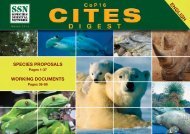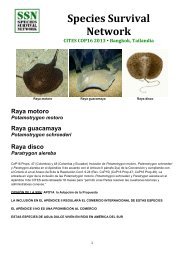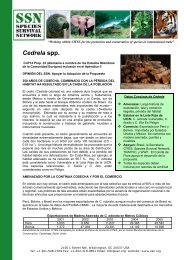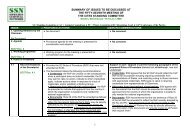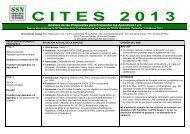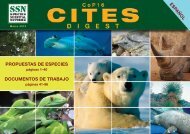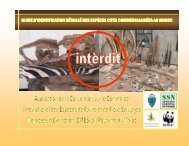SSN's Comments on South Africa's Regulations on Threatened and ...
SSN's Comments on South Africa's Regulations on Threatened and ...
SSN's Comments on South Africa's Regulations on Threatened and ...
You also want an ePaper? Increase the reach of your titles
YUMPU automatically turns print PDFs into web optimized ePapers that Google loves.
submitted in this applicati<strong>on</strong> for a permit is complete <strong>and</strong> accurate to the best of my knowledge <strong>and</strong><br />
belief. I underst<strong>and</strong> that any false statement herein may subject me to the criminal penalties of [insert<br />
relevant enforcement regulati<strong>on</strong>s]. Signature of the applicant _____________. Date _______________.<br />
• Date the activities are to be c<strong>on</strong>ducted. This is needed to determine the c<strong>on</strong>servati<strong>on</strong> impact of the<br />
activity (due to seas<strong>on</strong>ality of breeding / births or nesting, for example).<br />
Compulsory c<strong>on</strong>diti<strong>on</strong>s subject to which hunting permits must be issued<br />
Clause 21(1)(a)(vi) disallows hunting by bow <strong>and</strong> arrow “except where specifically permitted by<br />
provincial legislati<strong>on</strong>”. This means that allowance of this type of hunting will not be c<strong>on</strong>sistent from<br />
province to province, which would not ensure that activities with threatened <strong>and</strong> protected species are<br />
regulated in a uniform way across the country. The types of animals that may be bow hunted in each<br />
province are not publicly known, making evaluati<strong>on</strong> of this draft clause impossible. We recommend not<br />
allowing excepti<strong>on</strong>s to the prohibiti<strong>on</strong> <strong>on</strong> hunting by bow <strong>and</strong> arrow.<br />
Recommended new sub-clause 21(1)(a)(…) “nets” (such as with birds).<br />
Recommended new sub-clause 21(1)(a)(…) “sling shots” (such as with birds).<br />
Clause 21(1)(a)(x) states that permits authorizing the hunting of listed animals are subject to c<strong>on</strong>diti<strong>on</strong>s<br />
which include that the animal may not be hunted by means of “any other device which use would result<br />
in injuring or killing an animal in a way that is not humane”. Humane is not defined in the draft text.<br />
Regarding the definiti<strong>on</strong> of “humane”, many organizati<strong>on</strong>s that seek to prevent cruelty to animals<br />
c<strong>on</strong>sider hunting, generally, to be cruel. The reas<strong>on</strong> for this is that it is that animals that are hunted<br />
often do not loose c<strong>on</strong>sciousness <strong>and</strong> die instantaneously; that is, they are not killed humanely. While<br />
some wounded animals are sought <strong>and</strong> eventually killed by the resp<strong>on</strong>sible hunter, many are never<br />
recovered <strong>and</strong> suffer <strong>and</strong>/or die from their wounds minutes, hours, or even days or weeks later. In<br />
additi<strong>on</strong>, causing an “injury” to an animal is obviously inhumane because the animal is wounded <strong>and</strong> in<br />
undoubtedly suffering. The use of the word “humane” is also misleading <strong>and</strong> may be seen by some as<br />
an indicati<strong>on</strong> that hunting that is permitted under the draft regulati<strong>on</strong>s is ‘humane’. We recommend<br />
changing this sentence to read, “any other device which might not result in the instantaneous killing of<br />
an animal”.<br />
Clause 21(1)(b)(i) allows leopards <strong>and</strong> li<strong>on</strong>s to be hunted by luring the animal by means of bait,<br />
provided that the use of dead bait is allowed by provincial legislati<strong>on</strong>. First, we do not underst<strong>and</strong> how<br />
hunting leopards <strong>and</strong> li<strong>on</strong>s over bait can be c<strong>on</strong>sidered to be ethical c<strong>on</strong>duct or provides the animal<br />
with a “fair chance” of evading the hunter, which are qualificati<strong>on</strong>s stipulated in the related Draft<br />
Nati<strong>on</strong>al Norms <strong>and</strong> St<strong>and</strong>ards for the Regulati<strong>on</strong> of the Hunting Industry in <strong>South</strong> Africa. Sec<strong>on</strong>d,<br />
provincial legislati<strong>on</strong> regarding hunting of leopards <strong>and</strong> li<strong>on</strong>s over bait varies from province to<br />
province; deferring to provincial legislati<strong>on</strong> <strong>on</strong> this key issue will not ensure that these regulati<strong>on</strong>s are<br />
applied in uniform way across the country. Third, it is inc<strong>on</strong>sistent <strong>and</strong> inexplicable to provide an<br />
exempti<strong>on</strong> for leopard <strong>and</strong> li<strong>on</strong> hunting from the general rule that prohibits hunting animals by means<br />
of bait.<br />
Clause 21(1)(b (iii) states that animals may not be hunted by luring the animal by means of “smell”.<br />
While we agree that this is a useful sub-clause, we w<strong>on</strong>der how it can be practically enforced.<br />
8


